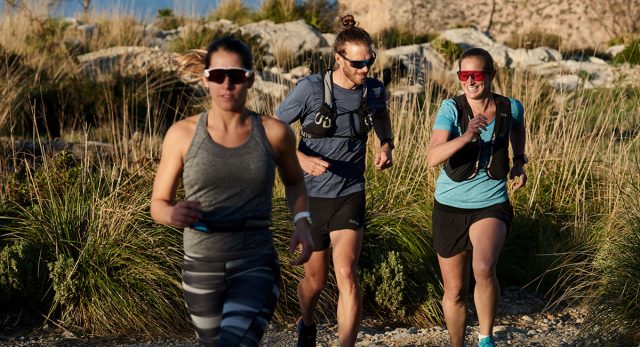Runner’s high is that blissful, euphoric feeling that comes during a run that can suddenly make your workout feel easy, almost as if you’re gliding through the air with your feet barely touching the ground.
This ability to get “high” while you run occurs from chemicals in the brain being released, and as a result you feel happy and motivated to run harder.
But the how and why we experience runner’s high on some runs and not others is still a mystery to most runners.
If you’re hoping to tap into this euphoric feeling more often, this guide will help you understand the science and experience behind the phenomenon known as the runner’s high, featuring expert advice from Dr. Bradford Cooper of Catalyst Coaching Institute and real-life experiences from professional runners.
In This Runner’s High guide, we’ll cover:
What is Runner’s High?
The concept of runner’s high generally indicates a feeling of happiness by the individual that is usually accompanied by reduction in stress and a decrease in pain.
As a result, anything that results in a person feeling better, or higher than they were when they started, could be interpreted as a high, opening the door to a wide range of potential physiological and psychological influences.
Athlete Experience: Lucy Charles-Barclay, triathlete
“For me, runner’s high can have two levels. In the first level, I can feel my mind clear and I’m just enjoying the feeling of running and the scenery around me.
On other occasions, this feeling can go to another level and everything is completely in balance and feels effortless. I can be completely focused on any one thing and my running is completely automatic. At this point, my speed is faster than normal but it feels effortless.”
The Science Behind Runner’s High
Scientifically, a study by Fuss, et al in 2015 noted the runner’s high has been hypothesized as the result of exercise-induced endorphin release.
Studies show that exercise increases endorphins and feelings of happiness and can treat and reduce the risk of depression, stress, anxiety and other mental health issues. There is likely a connection between these positive results and those associated with runner’s high.
When you push hard while exercising, endorphins work similarly to pain-reducing medications, acting as a natural counter balance to the discomfort you may be feeling.
Endorphins…
are a chemical in the brain that can release feelings of happiness and provide motivation during hard training, making the experience a positive one.
While the number of endorphins can vary, the more endorphins released the greater the feelings of and bliss.
EndoCannabinoids
What’s interesting is that researchers point to evidence suggesting endocannabinoids may play a role in runner’s high, creating similar effects as the cannabis plant introduced into the blood stream.
Cannabinoid receptors are, in fact, crucial to the runner’s high, leading to that body and brain buzz runners often experience.
Opioids
Boecker, et al 2008 did a study that conducted brain scans on 10 athletes at rest and after two hours of endurance running and found that:
- Levels of euphoria were inversely correlated with opioid binding in prefrontal and limbic regions areas of the brain.
- These “region-specific effects in frontal-limbic brain areas are involved in the processing of affective states and mood.”
Can Anyone Achieve Runner’s High?
The degree to which you experience runner’s high can vary from person to person, and from run to run. It may be helpful to note that the lack of the appearance of a runner’s high on a specific run doesn’t mean it never occurs.
In fact, runner’s high can occur even if you don’t like running, or consider yourself a non-runner. In other endurance sports like cycling and swimming, the same feelings can occur within the brain.
So, if you’re a runner questioning what’s missing, some of the suggestions below can help.
The Benefits of Runner’s High
Runner’s high results in a person feeling better during physical exertion, and can lead to a wide range of physiological and psychological benefits.
Here are a few reasons why runner’s high is worth the attempts to achieve this zone during your runs:
You’ll be encouraged to run
Feeling good on your training runs results in positive feelings related to what you’re doing. This can be encouraging, and help you to feel happy or energetic about getting out the door for another training session instead of dreading it.
You’ll be happier
The body was intended to move. Barring illness or significant fatigue, we all generally feel far better after movement than from laying on the couch.
In today’s society, most of us spend more than our share of time on the couch, at a desk or in a car. Getting outdoors or even onto a treadmill provides the kind of movement the body craves.
Achieving runner’s high will boost your mood, lower stress, and make you an overall happier person.
It’ll help you get into a routine
Once you’ve experienced runner’s high, you’ll realize what running can do for your body and mind. By seeking this blissful feelings during training, you’ll be more likely to run more often.
This can help you get into a consistent running routine, leading to better performance and additional gains associated with weight loss.
Post-run feelings of satisfaction
Some runners are much more likely to experience that high following a race, tempo run or track session where maximum effort is put forth.
When that effort results in meeting/exceeding your expected performance, feelings of joy are a natural result.
Cause and effect
There are few things in the modern world that provide us with a direct cause and effect.
Work, relationships, and other pursuits theoretically reward effort, but the number of variables are so extreme that it can be difficult for any of us to directly experience the fruits of these labors.
Knowing that you’re reaping the benefits with each step can provide a feeling of elation upon completion — what I did matters!
Running is different. Barring injury, if you run more miles, or faster miles, or put forth a greater effort during intervals or hill repeats, that can be measured objectively over time. That feels good.
ATHLETE EXPERIENCE: Jose “Chema” Manuel Martinez, LONG-DISTANCE RUNNER
“Runner’s high is one of the moments in which your body is in a state of well-being, a sensation in which you are your true self.
You become aware of your whole body and feel empowered and prepared to achieve any proposed goal.
The main benefit is to feel capable of reaching your full potential and achieve anything you want.”
How to Achieve Runner’s High
Most runners achieve runner’s high running at a moderate intensity for an extended period of time. That’s because when under duress, your body produces cortisol, a stress hormone, that stimulates the production of endorphins and endocannabinoids.
Whether you’ve felt runner’s high consistently or never before, there are some things you can do to increase your chances on your next run:
- Keep in mind that runner’s high isn’t the same for everyone and it can be triggered by different types of runs.
- Keep an open mind, experiment and jot down notes in your running journal to spot any consistent patterns in your training that lead to these euphoric feelings.
If you’d like to increase the likelihood of experiencing runner’s high, below are a few tips you can use to help.
Note: Any time you’re increasing your intensity level, make sure to discuss it with a healthcare professional before proceeding.
1. Up the pace
Running the same distance at the same speed or effort may make this feeling harder to achieve. However, if you’re willing to push yourself to see how the body responds, you’re chances of getting into the runner’s high state increase.
Try running up to 85% of your maximum heart rate for at least few miles in order to place your body under stress. This will allow those good chemicals in the brain to be released.
2. Get outside
A growing number of studies show that exercise in natural settings (parks, trails, etc.) have more of a positive impact than the exact same effort indoors.
That isn’t to say treadmills and other indoor options aren’t valuable — jumping on the treadmill is a great idea when snow or ice make for hazardous conditions.
But all things being equal, the outdoors likely provide additional opportunities to boost runner’s high.
3. Go long
If going fast just isn’t your thing, it’s possible to achieve runner’s high going slower — but you’ll need to go long to do so.
Up your runs to two hours or more at marathon pace.
4. Run more often
If you’re a beginner, chances are runner’s high will be more difficult to achieve.
This is because everything is painful and uncomfortable, it’s harder to get into the kind of grove for extended periods needed to achieve these feelings.
By training consistently over several months, you’ll increase your chances.
5. Take diet and sleep more seriously
What you eat and how much you sleep affect your training. If your diet is poor and you aren’t getting enough sleep at night to recover properly, you’re probably not going to feel good when you run.
It’s also harder to push yourself if you’re tired or lacking energy, and achieving runner’s high is about pushing yourself for longer durations.
6. Build mental toughness
This study on the concept of functional mental toughness pointed to three primary aspects that influence mental toughness.
One of these is the concept that mental toughness is likely based more on cognitive strategies than the classical grit-your-teeth toughness that’s often highlighted in the movies. These would apply to setting the stage for the runner’s high, too.
7. Reflect
Are you going through the motions during training, or are you pushing yourself to get better?
Psychological benefits might be limited when you’re simply checking the boxes, but when you’re truly pursuing a better version of yourself, the outcomes reflect that pursuit.
Athlete experiences
Let’s take a look at what some of the top endurance athletes on the planet had to say about the type of training that makes it easier for them to achieve runner’s high:
Triathlete Chris Leiferman:
“Long, easy runs tend to give me the best high. If it’s too short, I probably didn’t reach my limit. So the longer I go at an enjoyable pace, the more fulfilled I am.”
Triathlete Lucy Charles-Barclay:
“I love running in the forest, especially Epping forest, because it has so many things to look at and the terrain changes all of the time. Instead of upsetting my rhythm, it allows me to zone out and let my natural running form take over. My track sessions and park runs can be fun but generally they are just hard work with lots to focus on. Give me the forest any day of the week, this is where I find it easiest to get the that high state.”
Long-distance runner Scott Fauble:
“I think the runs that yield the largest feelings of satisfaction and make me feel like I’m fulfilling my purpose are really hard workouts. When I’m going flat out and everything is screaming at me to stop, that’s when I feel something most resembling runner’s high.
To Sum It Up: Running Towards Runner’s High
Just like running shoes, cadence, or stride length, achieving runner’s high will vary from person to person. The key is trial and error and not worrying too much if you can’t get into this zen-like state. Pushing yourself to become the best runner you can be will ultimately lead you to achieving runner’s high.
This will allow your mind to reach a calm and peaceful state that’s free of stress, and may make it easier for you to slip into this zone during your runs too.
For some, runner’s high can feel similar to meditation. If you’ve rarely gotten into this state, try practicing meditation before your runs.
Other runner’s may find distractions like listening to music or concentrating on nature to be more relaxing, making it easier to push yourself while remaining happy.
Whatever the case may be, runner’s high is ultimately a reward for all of the hard work you put in on the road and trail. It’s not something to be stressed about when you don’t achieve it, but rather a feeling to be enjoyed when it comes your way.
Athlete Experience
Long-distance runner Scott Fauble:
“I try not to focus on anything. I certainly don’t think that you can force a runner’s high. All you can do is be present and embrace the moment.”
If you liked this post, don’t forget to share so that others can find it, too.
Or give it a thumbs up!
I like this article
Please note that the information provided in the Polar Blog articles cannot replace individual advice from health professionals. Please consult your physician before starting a new fitness program.





